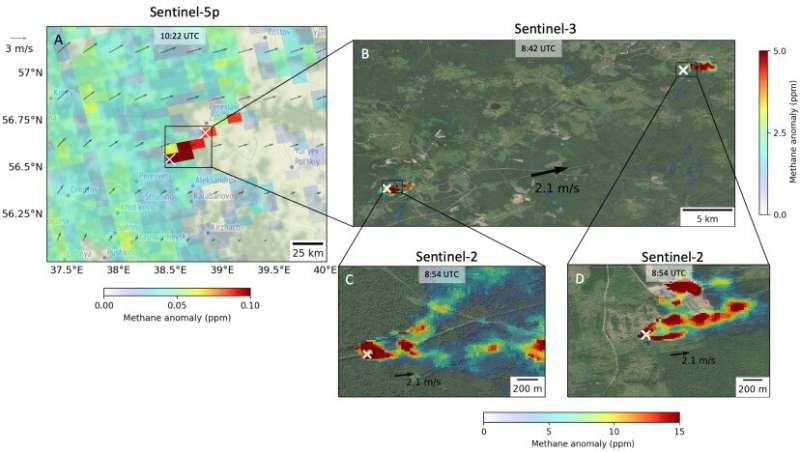January 4, 2023 report
This article has been reviewed according to Science X's editorial process and policies. Editors have highlighted the following attributes while ensuring the content's credibility:
fact-checked
preprint
trusted source
proofread
A new way to spot methane leaks globally

A team of researchers from the Netherlands, the U.S. and Canada has found a new way to spot methane leaks around the globe. The group has published a paper describing their combined satellite approach on the arXiv preprint server.
Prior research has shown that carbon dioxide is not the only greenhouse gas—human-produced methane emissions are also helping to heat up the planet. Methane does not last as long in the atmosphere, but it traps more heat; thus reducing emissions would reduce the overall rate of planetary warming.
Methane emissions have a variety of sources, the two largest being animal flatulence (including human) and leaks at oil and gas facilities. Over the past several years, scientists have worked to reduce methane emissions that result from leaks and controlled releases to prevent explosions due to pressure buildup. But these efforts have been stymied by governments and corporations that show little interest in reducing emissions and a lack of technology that can be used to spot leaks and releases. In this new effort, the researchers have found a highly accurate way to spot such emissions.
The new method evolves the use of data from three satellites. The first is Sentinel-5, which was launched in 2017. It has sensors that can spot methane plumes, but it only has a resolution of 7 kilometers. That is not high enough to track down a leak. To improve its resolution capabilities, the researchers compared data from Sentinel-5 with data from two other satellites, Sentinel-2 and Sentinel-3, both of which have much higher resolutions than Sentinel-5. But neither has the kind of sensors needed to spot a methane plume. Using data from all three satellites, the researchers found that they could spot plumes to a resolution of just 5 to 10 meters.
The researchers proved their system is accurate by focusing on a methane plume they found near Moscow. A closer look showed it to be two plumes 5 kilometers apart. Both were found to be controlled gas pipeline leaks that lasted a single day. The researchers also spotted a plume in Algeria that was leaking methane at 68 metric tons per hour, which turned out to be part of a gas blowout—a normal part of gas well maintenance.
More information: Sudhanshu Pandey et al, Daily detection and quantification of methane leaks using Sentinel-3: a tiered satellite observation approach with Sentinel-2 and Sentinel-5p, arXiv (2022). DOI: 10.48550/arxiv.2212.11318
Journal information: arXiv
© 2023 Science X Network



















